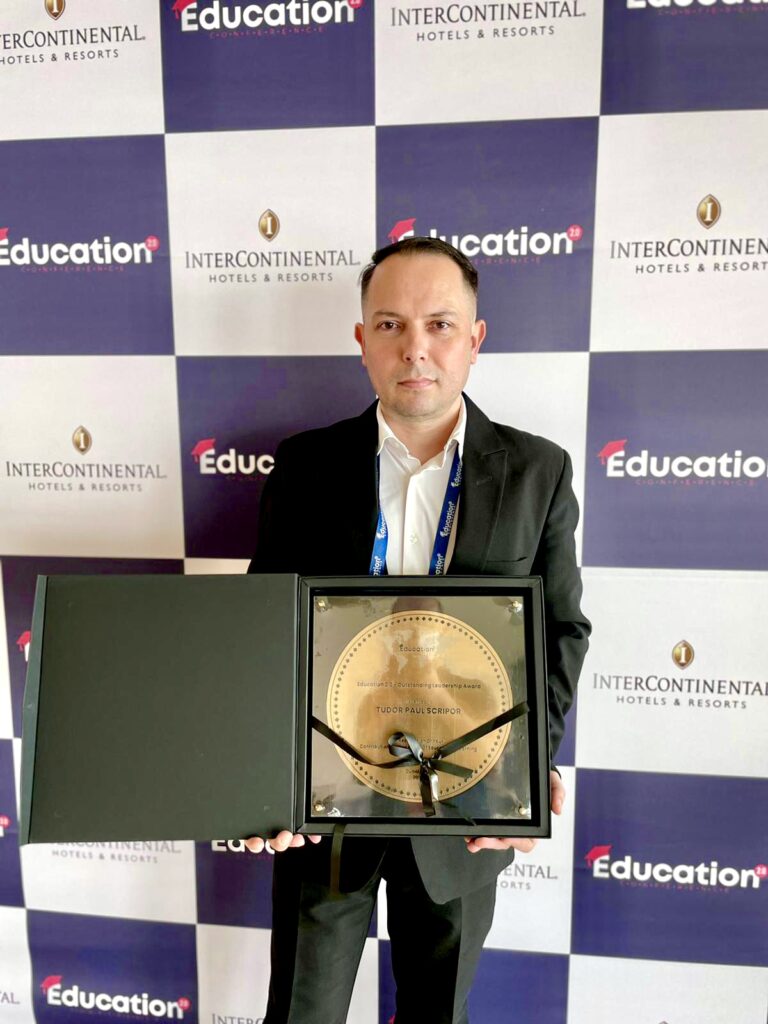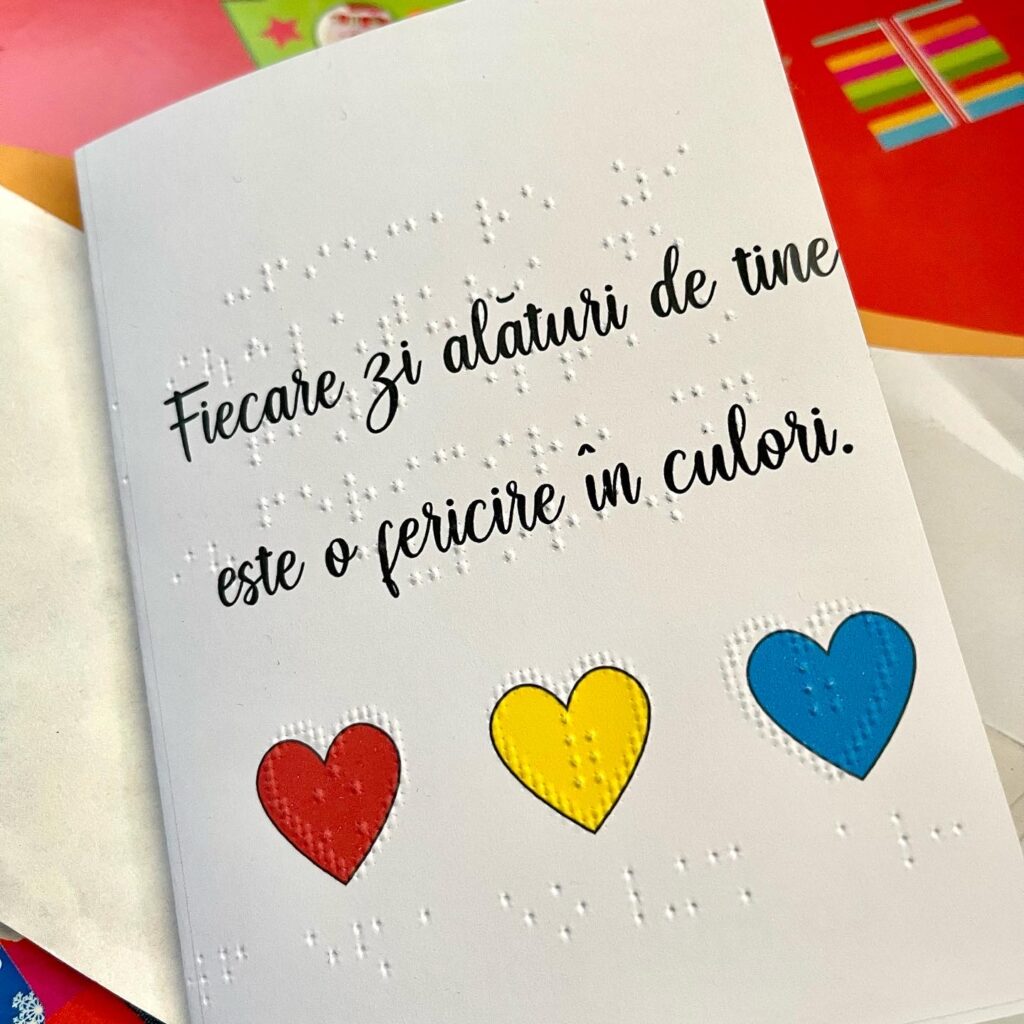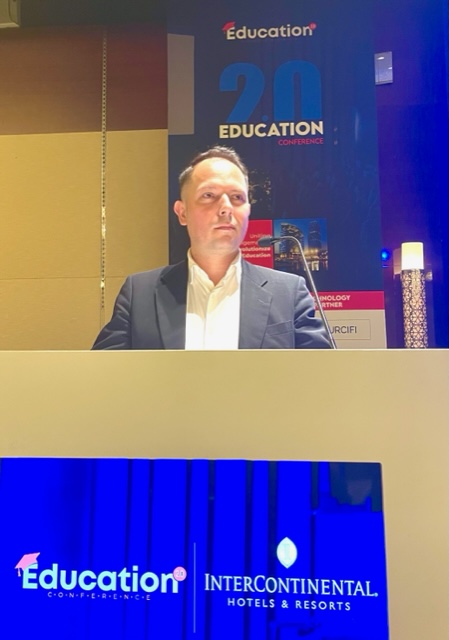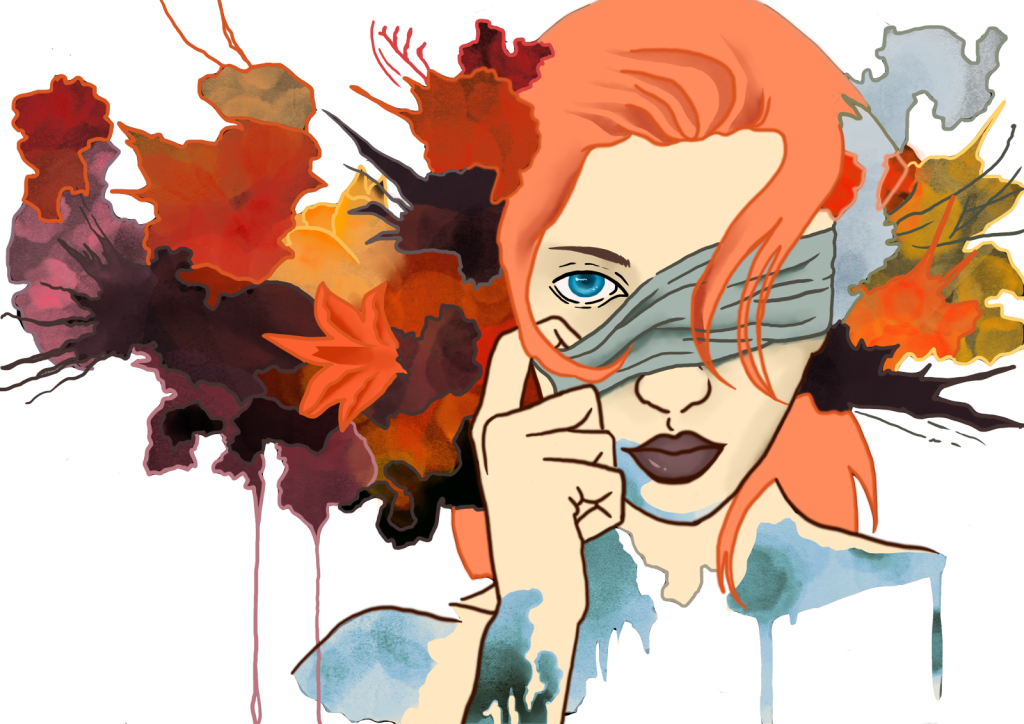It is truly impressive when individuals with various disabilities manage, through determination and passion, to turn their life stories into examples for everyone who gets to know them. Equally fascinating is when people without disabilities choose to dedicate their lives to help others and, through their actions, make the surrounding environment accessible to everyone. These are the people who show us that a better world is one in which each of us contributes and gives our best not only for ourselves but especially for those around us.
That being said, I joyfully and warmly invite you to meet Tudor Scripor, an artist and the founder of an association that bears his name. The association aims to make the world of colors accessible for visually impaired individuals, a project we will discuss in more detail later.
Sharing experiences through and in art
Tudor was born in Cluj, or as he says, in the “heart of Transylvania,” on June 7, 1979. Among his cherished memories, pencils, brushes, watercolor sets, and sketchbooks hold a special place. They were his best friends, inseparable companions, who helped him overcome both good and challenging days:
I will always remember how, during winter, when the power went out, I would draw, color, or paint by the light of candles. Tudor Scripor
Tudor Scripor
Tudor’s immense love for these seemingly ordinary objects led him to attend the Arts High School in Cluj, and later, the Iconography department within the Faculty of Theology at Babeș-Bolyai University. “Since high school, I have felt the need to share my experiences through and in art. As a result, I have had over 20 personal painting exhibitions, particularly using the technique of ‘oil on glass,’ both in Romania and abroad,” explained Tudor.

A true artist at heart, he desired that others could also enjoy his passion, leaving something beautiful behind through his creations, much like the rainbow that remains after the rain, enchanting us with its mosaic of colors, symbolizing hope and beauty in its deepest meanings.
I have always felt that my life is dedicated to serving art, especially colors, but also people. I revolve around colors and constantly seek new ways to express myself through them. For a while, I was part of a team that painted churches, and with some of the money earned from that project, I established an art gallery. Later on, based on my own recipes for color creation, I founded a small factory appropriately named “The Color Factory,” which produced colors and painting materials for artists.
Tudor Scripor
The Alphabet of Colors
Despite having such a rich track record, Tudor did not limit himself to that alone. His love for everything related to color and beauty has shown that there are no boundaries that cannot be overcome when the soul becomes the brush that paints upon hearts. Tudor’s passion materialized in the creation of the “Alphabet of Colors”, a project aimed at making colors accessible to the visually impaired and individuals with certain visual impairments. The goal is to enable everyone to have access to this astonishing world of expressive shades.

In 2012, during a painting workshop, Tudor came into contact with a visually impaired person and reached the conclusion that colors should become a language that everyone can understand and enjoy.
As an artist, I couldn’t imagine nor accept that, for some of our fellow human beings, the world lacks colors.
Tudor Scripor
The “Scripor Alphabet” Association
After extensive studies, years of research, and numerous attempts, Tudor managed to achieve the impossible: creating an alphabet of colors, a way for the visually impaired and individuals with visual impairments to tactually distinguish and differentiate colors by touch.
“Over time, a growing international community has formed around me and the program I developed, called the Scripor Alphabet Association. The community is complex and diverse, consisting of blind children, youth and adults, educators, teachers, psycho-pedagogues, doctors, researchers, architects, IT programmers, scientists, athletes, and volunteers,” Tudor shared with us.
I know that I have sparked your interest regarding this alphabet of colors, which is as ingenious as it is amazing because few people imagined that visually impaired individuals could perceive colors in any way. Tudor shattered the myth and demonstrated that it is possible, explaining to us the method, as complex as it is practical, by which fingers can replace eyes, and imagination can take the place of the retina.
Inspired by the life and work of Louis Braille, the Scripor Tactile Alphabet is based on the Braille writing system. My alphabet takes the form of a system of dots that encode colors in a simple and universal manner. This code promotes equal opportunities for all individuals with visual disabilities. Now, these individuals have the ability to identify, write, read, recognize, and differentiate colors effectively. Moreover, the Scripor alphabet is the pathway through which people with visual disabilities gain access to everything around them. This concept will significantly improve their quality of life, provide them with a sense of belonging, and enhance their level of safety and autonomy.
Tudor Scripor

“The King of Colors,” because I believe he truly deserves this title, goes beyond the accessibility of colors and aims to implement this system in the practical lives of visually impaired individuals.
Tudor Scripor
“I embarked on this journey with the intention of bringing color where it doesn’t exist. A multitude of products, services, professions, and concepts have now become accessible to everyone. For example, during Christmas, with excitement and joy, I witnessed visually impaired individuals decorating the Christmas tree. Each person was able to choose ornaments based on color. The emotion was overwhelming! With the help of technology and the tactile color alphabet, these amazing people were able to independently coordinate their clothing colors or choose belts for kimonos based on the colors representing their martial arts ranks during a competition,” Tudor recounts.
International Medals
The fact that an increasing number of accessibility specialists worldwide consider the Scripor Alphabet to be one of the most important innovations for the inclusion of visually impaired individuals is a testament to its significance and utility. It highlights the major contribution Tudor has made in the service of humanity. While he has been honored and will likely receive more medals and similar distinctions, his greatest satisfaction, his true reward, comes from seeing how his idea has materialized into concrete actions that help others.
Regarding awards and recognition, in 2019, for the first time, I presented my invention at the International Exhibition of Inventions and Innovations in Geneva. At the exhibition, I received the Gold Medal in the Education, Culture, and Art category, as well as the Grand Prize from the Association of German Inventors. These awards were presented to me by the President of the European Inventors Association, Joachim Bader.
Tudor Scripor

Following that, over 15 national and international recognition diplomas and medals followed. “I am honored to be recognized by the international community as a remarkable leader in education for my invention(…) Every time I am aware of the significant impact this invention has, and my life, which I have dedicated to art and colors, now supports people,” emphasizes the inventor, adding, “The most important recognition for me is knowing that the efforts of my work contribute to improving the lives of millions of blind children, youth, and adults worldwide.”
Although it may seem unbelievable, even though you might have expected me to stop here, I can tell you that it is not the case, because Tudor did not limit himself to all that has been mentioned so far. Through his company, he has provided employment opportunities for the visually impaired and has adopted initiatives involving low-cost or even free services, all aimed at facilitating the lives of individuals with visual impairments.
The Long Road to Recognition
“The King of Colors” obtained his crown with great difficulty, having to go through crucial moments and facing challenges along the way. However, these obstacles did not deter him from realizing his dream of creating a world where colors are accessible to everyone, and where anyone can step confidently and enthusiastically.
“I’m not ashamed to admit that there were moments when I couldn’t find any solutions. And it happened more than once! Those who know me know that I am a person who never gives up the fight, no matter how tough it gets. Along the way, I discovered that all my predecessors had failed. Alone, encouraged only by my wife, I set out on this journey with the desire to bring color where it did not exist. To my surprise, I encountered many refusals and resistance from certain individuals in the country. On the other hand, they attempted to sabotage or condition the implementation of the alphabet based on their own interests.
During the development process of this technology, I faced a series of challenges, especially from people who should have contributed to improving the lives of the visually impaired community. Despite the challenges, remarkable people joined me in the process, working for the greater good. They believe in the idea and understand the impact this solution can have. Additionally, international awards and the encouragement from communities in Romania and other continents provide us with the energy to continue developing the project globally.”
The President of the European Inventors Association, Dipl. Ing. MBA INSEAD, Mr. Joachim Bader himself, stated that even Tudor’s surname predicted the important role he would play on the stage of life. The term “script” comes from the Latin word “scriber,” meaning to write, to write using a specific alphabet.
Through his determination and dedication to art and people, Tudor demonstrates that the human being has extraordinary capabilities. By putting them in the service of the community, one ensures their name is engraved on the wall of history for eternity. He has succeeded, with energy and ambition, in accomplishing what even doctors fail to do in many situations: restoring sight to the blind and making the world we live in a better place for each of us.
A material created by Andreea Maftei (a second-year student at Babeș-Bolyai University, studying Comparative Romanian Literature). Andreea is a media.hub intern through the bilateral agreement with UBB Cluj and is visually impaired.
Editing: Radu Eremia
Proofreading and layout: Iulia Dromereschi
Original illustrations by Ioana Stănișor

